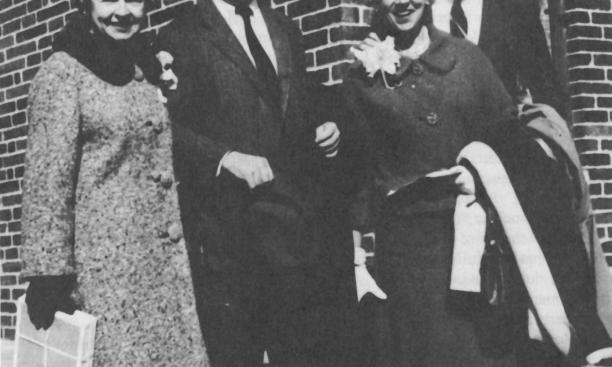

It’s better to burn out than to fade away.
-- Neil Young
They called it the Crime of ’96. Moses Taylor Pyne 1877 was a huge mover and shaker of the College trustees and one of the architects of the 1896 Sesquicentennial, the literal coming-out party of the renamed Princeton University. He – well, supposedly his mother – was giving a new (and desperately needed) library to the College, uh, University, to augment and overshadow the tiny Chancellor Green. He wanted it next door, facing Cannon Green, and he was the chair of the building and grounds committee. East College, the older dormitory twin of West College, had to go. The generations of alums who had lived there were not against progress, were proud to have a University, were happy to have Pyne’s bucks and a new library.
But they still called it the Crime of ’96. People do not go around tearing down your idyllic youth and escape unscathed. The irony that Pyne himself had lived there with his brother was lost in the anger: They were obliterating my treasured past. The gothic design of the new library didn’t help either, adding a discordant element to the colonial atmosphere of the space accented by the Greek temples of Whig and Clio; I mean, who was interested in gothic? Of course, the answer was Pyne; by the time he died in 1921, more than half the campus was collegiate gothic. But even then, the destruction of East College still was known as the Crime of ’96.

Thanks to an enthusiasm for renovation and some serious rehab funding, Princeton rarely tears down an on-campus dorm; when it does, the echoes of the Crime of ’96 seem to rise from the grave of East College. It was 1965 before another was leveled, and that was only because 95-year-old (and badly mislocated) Reunion Hall literally was condemned. Of the extremely few pieces that remained sound, only its 14 stars (in memory of the war dead from the classes of 1911 to 1946 who had resided there) remain on the wall of the adjacent West College. Still, a lead letter to the PAW editor lambasted the “wanton plan ... causing countless turnings in the grave.” Thankfully, however, most observers regarded the resulting open space as an aesthetic step forward. But the Crime of ’96 hardly was forgotten.
Another 40 years passed before the next unavoidable dorm-demolition project, and it involved a serious new wrinkle, potentially touchier than even the Pyne Library misadventure. There was no Joe East 1833 or Charlie Reunion 1870 to resent the demise of their namesakes, but three of the dorms in the New New Quad (as opposed to the Old New Quad – please, please don’t ask) were given by alums who are very much around: the Classes of 1940, 1941, and 1942. Not to mention two trustees who, while gone, are large in memory: Donold Lourie ’22 and his longtime friend, George Love ’22.
Having come here in the middle of a Depression and ending up in a world war – 89 members of the three classes died in military service – the classes of ’40, ’41, and ’42 certainly deserve all the respect you can muster. The leveling of 1940, 1941, and 1942 halls, which they had generously donated in 1964, obviously didn’t qualify. But the New New Quad had been built fast, ironically in part to replace the crumbled Reunion Hall, and the University was thin on the bucks. In the words of then-president Bob Goheen, super-ironically a member of the Class of 1940 himself, we did much of it “the cheap way.” As a result, when it became necessary to rehab the five dorms in 2007, they were essentially impossible to bring up to code. The wreckers moved in instead.
Presumably averse to the prospect of the phrase “the Crime of ’07,” the powers that be swung into action, engaging the representatives of ’22, ’40, ’41, and ’42 in order to ensure the continuity of dignity and honor, even in the absence of strange chocolate brick and odd ironwork. The class time capsules in the cornerstones of each dorm were retrieved before demolition, freshened up, and readied for reinstallation. The new evergreen Butler College dorms for the site were arranged carefully with nice memorial spots. So while the class names no longer adorn buildings down campus, the new Butler College amphitheater contains beautiful flagstones for each class, beneath which their time capsules now reside, and the comfy adjacent Class of 1942 lounge has display cases of the classes’ memorabilia. There are also memorial stones to each in the Chapel, a nice connection to a much broader range of past Princeton generosity and service.

Of course, the case of Lourie and Love and 1922 is special. They got the New New ball rolling by giving Lourie-Love Hall in 1964, and they got their class to give a dorm, too. Later, Cupe Love also gave soccer’s Lourie-Love Field in the memory of their friendship; of course, that’s now gone as well, replaced by spiffy new Roberts Stadium. So the north pavilion of the new stadium, where the Tigers’ soccer championship banners reside, has been renamed the Lourie-Love Pavilion to honor the old field; pointing toward it across Poe Field and running through the center of rebuilt Butler College is the new Lourie-Love Walk. Its motto embossed in the flagstone is actually apropos of the entire Butler rededication to all the donors of the New New Quad:
MEMORIA AMICITIAE EORUM SEMPITERNA
Along with many, many other Princetonians, I spent two years in waffle-ceilinged bliss in the quad. Of course, I was up campus my senior year, so I don’t really think of the Butler transformation as a crime of any sort. (Albeit you don’t feel any younger when they condemn your freshman dorm, which had been virtually new at the time.) But I’m pleased that the classes (and most certainly Lourie and Love), who all pitched in when Bob Goheen called their number, have been rehonored and gotten their day in the sun again. The friendships symbolized in their generosity and noted in the inscription are not merely of material benefit to us, their recipients. Their memory is a public good to be cultivated for its own sake, an abstract ideal that is far harder to unearth and display in today’s cacophonous world than in the mannered era of the Sesquicentennial.
In memory of their eternal friendship. The New New Quad is dead. Long live the New New Quad.
